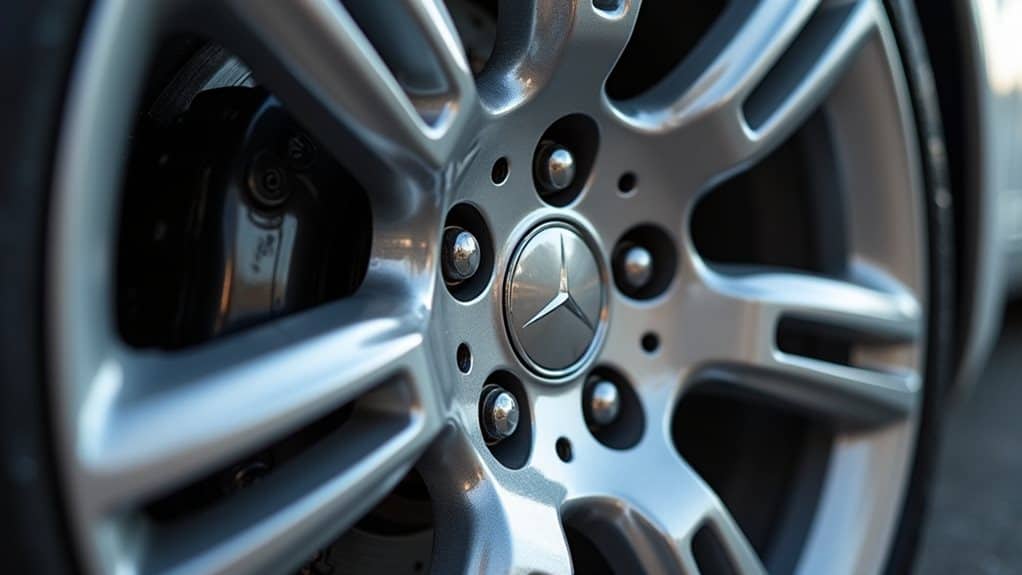To keep hubcaps from falling off, you’ll need to select the correct size by checking your tire’s sidewall for the “R” number, which indicates wheel diameter in inches. Install them properly by cleaning the wheel surface, aligning the valve stem opening, and pressing firmly around all edges until you hear a click sound. Perform regular inspections of retention clips and fasteners, replace worn components immediately, and avoid aggressive driving over potholes or debris that can loosen the clips. Following these thorough maintenance practices will guarantee your hubcaps stay securely attached.
Quick Tips
- Ensure proper installation by cleaning wheels thoroughly, aligning valve stems, and pressing firmly until you hear a click sound.
- Perform regular inspections for cracks, loose clips, and worn components, replacing damaged parts immediately to maintain secure attachment.
- Practice safe driving by avoiding potholes, reducing speed over bumps, and maintaining distance from curbs during parking maneuvers.
- Keep hubcaps and wheels completely dry after cleaning to prevent moisture from loosening fittings and retention mechanisms.
- Consider upgrading to locking systems, friction enhancement rings, or reinforced clips for improved security against vibrations and impacts.
Select the Right Size and Type of Hubcaps
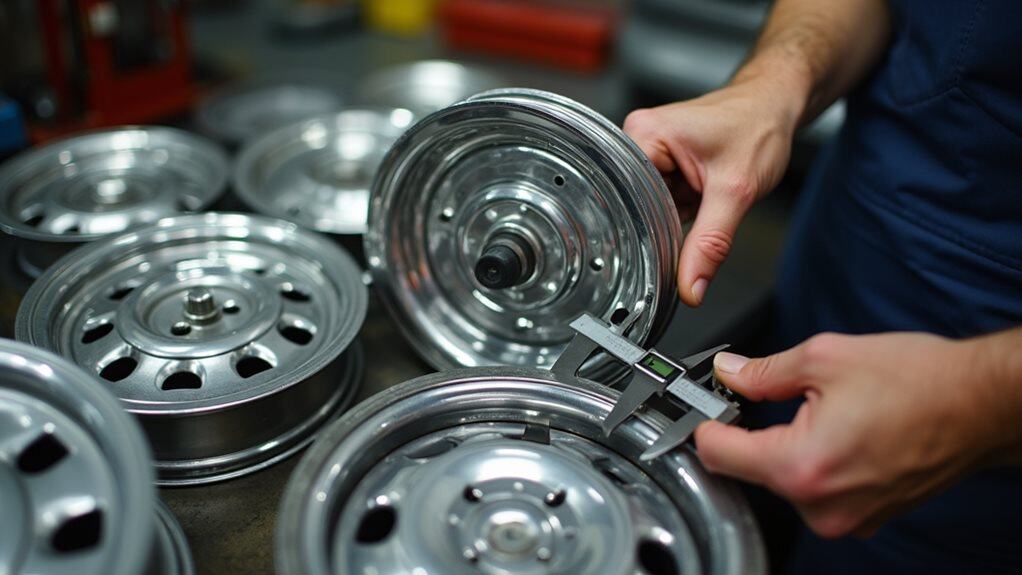
The first step in preventing hubcap loss involves selecting the correct size and type for your specific vehicle.
Check your tire’s sidewall for the “R” number, which indicates wheel diameter in inches.
You’ll need hubcaps designed for steel wheels with small round holes, as they won’t fit alloy wheels. Additionally, ensure that you choose high-quality parts to prevent premature failures and maintain performance.
Verify compatibility before purchasing.
Hubcap sizes typically range from 12 to 18 inches, with standard options including 13, 14, 15, 16, and 17-inch varieties.
Install Hubcaps Properly for Maximum Security
Once you’ve selected the correct hubcaps for your vehicle, proper installation becomes critical for preventing them from detaching while driving.
Clean the wheel surface thoroughly, removing dirt and debris.
Align the valve stem opening precisely with your wheel’s valve stem.
Press firmly around all edges using even pressure, then tap gently with a rubber mallet to secure completely. Listen for a click or secure sound that indicates the hubcap has locked into proper position. Additionally, ensure the tire fitment is correct to avoid any disruptions during driving.
Perform Regular Inspections and Maintenance
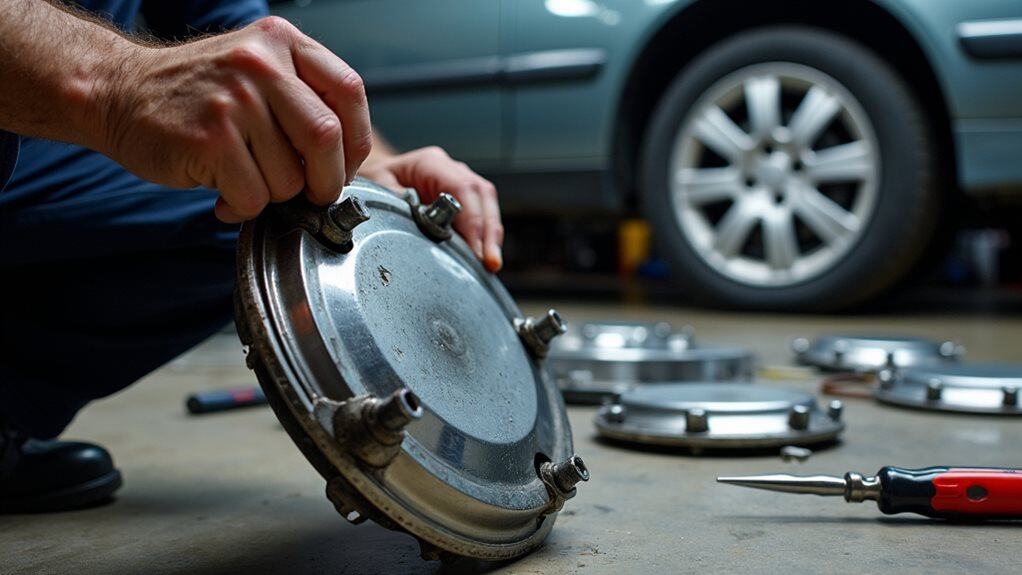
While proper installation sets the foundation for secure hubcaps, regular maintenance checks guarantee they’ll stay attached throughout your vehicle’s operation.
Perform daily visual inspections for cracks, dents, or loose fasteners during walk-around checks.
Monthly, examine hubcap seating and gasket condition more thoroughly. Check that retention clips remain secure and tighten fasteners to manufacturer specifications. Additionally, be aware that faulty components in your vehicle’s electrical system can lead to unforeseen issues that may affect other parts, including hubcap retention mechanisms.
Choose Quality Hubcaps With Durable Retention Systems
Quality hubcaps with strong retention systems form your first line of defense against unexpected wheel cover loss.
Look for spring steel clips or wire retention systems, which provide highly secure attachment when properly installed.
Choose ABS plastic hubcaps for their lightweight durability, reducing outward force during driving.
Steel retention rings offering 360-degree grip considerably improve stay-on ability. Additionally, ensure that your hubcaps are compatible with your vehicle’s specifications to prevent issues like transmission fluid issues that can arise from improper fitting.
Adopt Safe Driving Habits to Protect Your Hubcaps
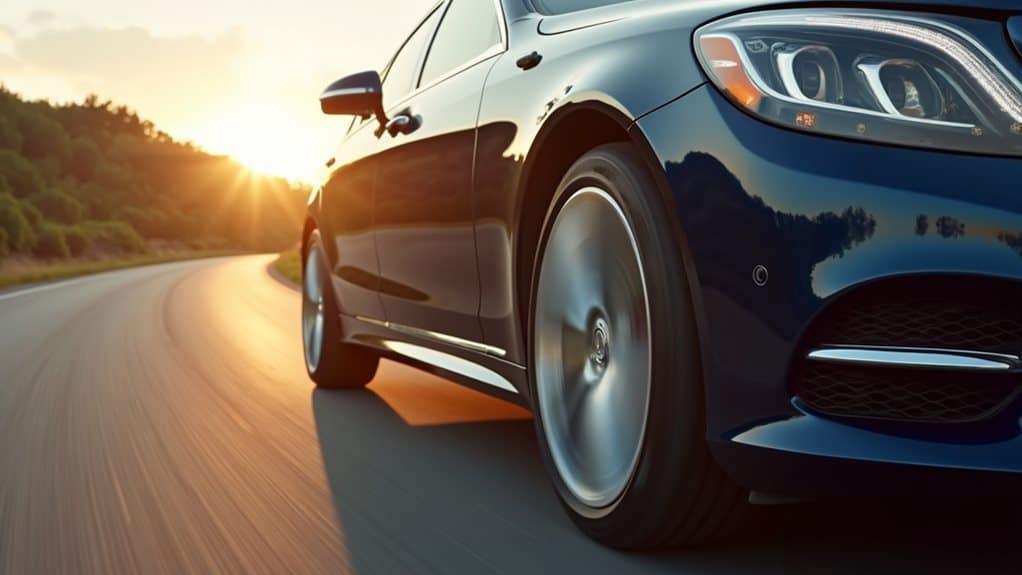
Your driving habits directly impact how well your hubcaps stay attached to your wheels, making it essential to modify your approach behind the wheel.
Road hazards like potholes, debris, and rough surfaces can instantly dislodge hubcaps if you hit them at high speeds, while sudden acceleration, hard braking, and sharp turns create rotational forces that gradually loosen the retention clips.
You’ll also need to exercise extra caution during parking maneuvers, since scraping against curbs or maneuvering tight spaces can physically knock hubcaps loose or damage their mounting systems.
Avoid Road Hazards
Since potholes and uneven road surfaces generate sudden jolts that can dislodge hubcaps from their mounting points, maintaining constant awareness of road conditions becomes essential for preventing hubcap loss.
You’ll need to scan ahead for debris, rocks, and rough patches while driving cautiously through construction zones.
Avoid aggressive maneuvers near curbs and reduce speed over bumps to minimize shock transmission.
Reduce Speed Impact
While avoiding road hazards provides one layer of protection, adopting safe driving habits offers another crucial defense against hubcap loss.
Maintain consistent moderate speeds to reduce impact forces on wheels from road irregularities. Avoid sudden acceleration and hard braking, which create rotational torque that loosens retention clips.
Practice smooth cornering to minimize lateral forces that stress hubcap attachments.
Careful Parking Maneuvers
Parking maneuvers present significant opportunities for hubcap damage that many drivers overlook.
Maintain proper distance from curbs using mirrors to judge clearance accurately. Execute controlled steering with slow, steady inputs rather than sharp turns.
Scan for obstacles like poles or debris before maneuvering. Apply gradual braking and acceleration to prevent jarring hubcaps loose from retention clips.
Use Additional Retention Accessories for Extra Security
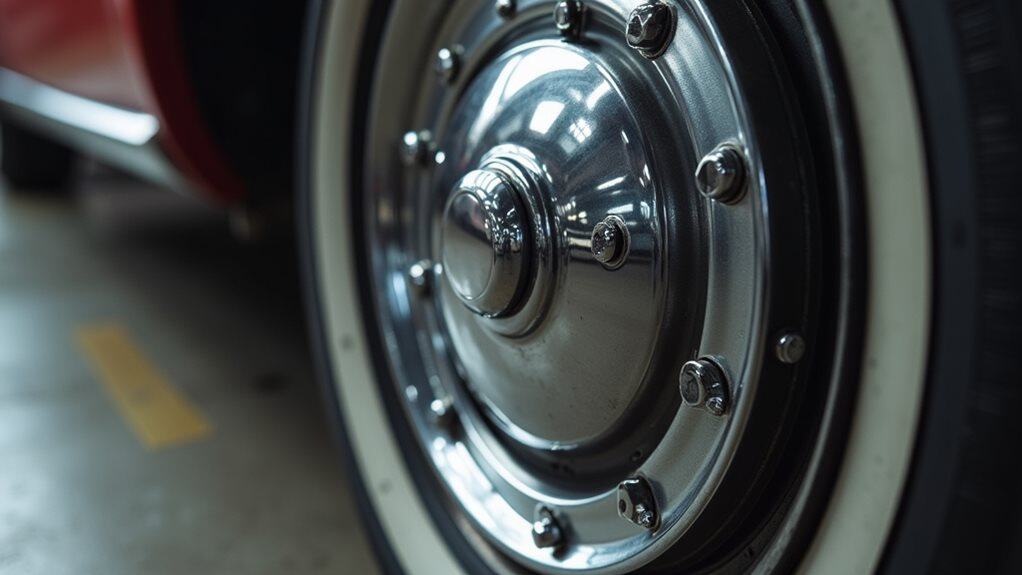
When standard hubcap retention methods aren’t providing the security you need, specialized accessories can considerably reduce your risk of losing hubcaps on the road.
Locking hubcap systems replace traditional clips with tamper-resistant mechanisms that require special tools for removal, while friction enhancement rings increase the grip between your hubcap and wheel surface.
You’ll also find clip reinforcement options that strengthen existing retention points, giving you multiple layers of protection against vibration, impact, and the everyday stresses that cause hubcaps to work loose over time.
Locking Hubcap Systems
Because standard hubcap retention methods don’t always provide adequate security against vibrations and road impacts, locking hubcap systems offer a more resilient solution to prevent wheel covers from detaching unexpectedly.
These systems use bolt-on designs with tamper-resistant hardware, creating mechanical connections that withstand rough conditions while protecting lug nuts from corrosion and environmental damage.
Friction Enhancement Rings
While locking hubcap systems provide strong mechanical security, friction enhancement rings offer an additional layer of protection that works by increasing the grip between your hubcap and wheel rim.
These rubber or silicone rings create tighter contact surfaces, absorbing road shocks and compensating for worn mounting clips through consistent pressure distribution and enhanced frictional resistance.
Clip Reinforcement Options
Beyond friction enhancement rings, you can strengthen your hubcap’s attachment system through various clip reinforcement options that provide additional security against road hazards and normal wear.
Spring steel clips offer flexible grip strength, while plastic tabs combined with metal rings enhance durability.
Detachable metal retention rings distribute pressure evenly, reducing clip fatigue and preventing unexpected detachment during driving.
Master Safe Removal and Reinstallation Techniques
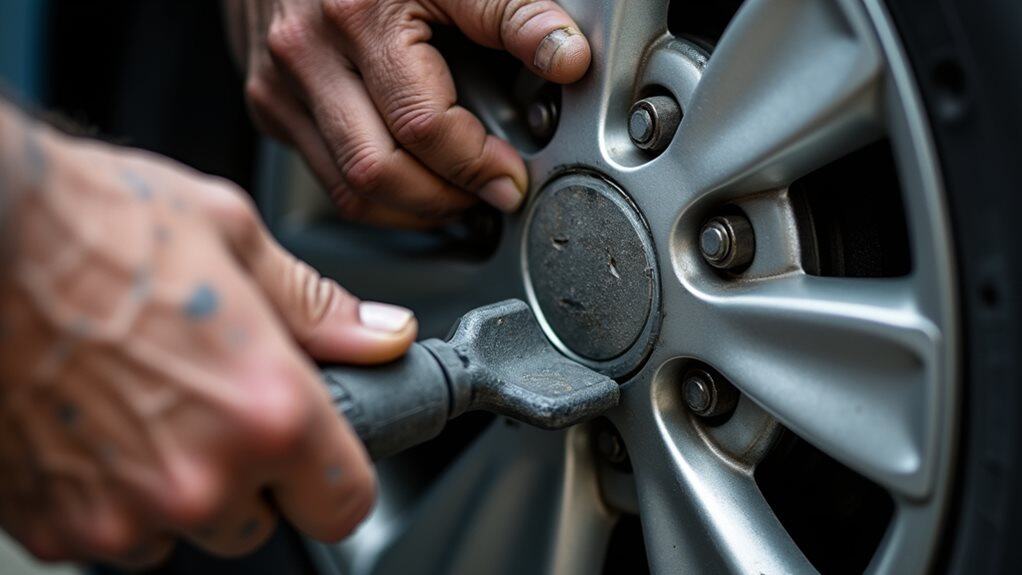
Become proficient in the art of hubcap removal and reinstallation to prevent costly damage and guarantee long-lasting attachment.
Use appropriate tools like lug wrenches, working gradually around the perimeter rather than forcing single points. Engage your parking brake first for stability.
During reinstallation, match valve stem cutouts precisely and press uniformly around edges for even distribution.
Clean and Prepare Wheels Before Installation
Before installing your hubcaps, thorough wheel preparation creates the foundation for secure, long-lasting attachment that prevents costly roadside failures.
Remove existing hubcaps carefully using plastic pry tools. Clean wheels with warm soapy water and soft-bristle brushes, reaching all crevices.
Dry completely to eliminate moisture that loosens fittings. Inspect rims for debris or damage affecting attachment.
Replace Worn or Damaged Components Immediately
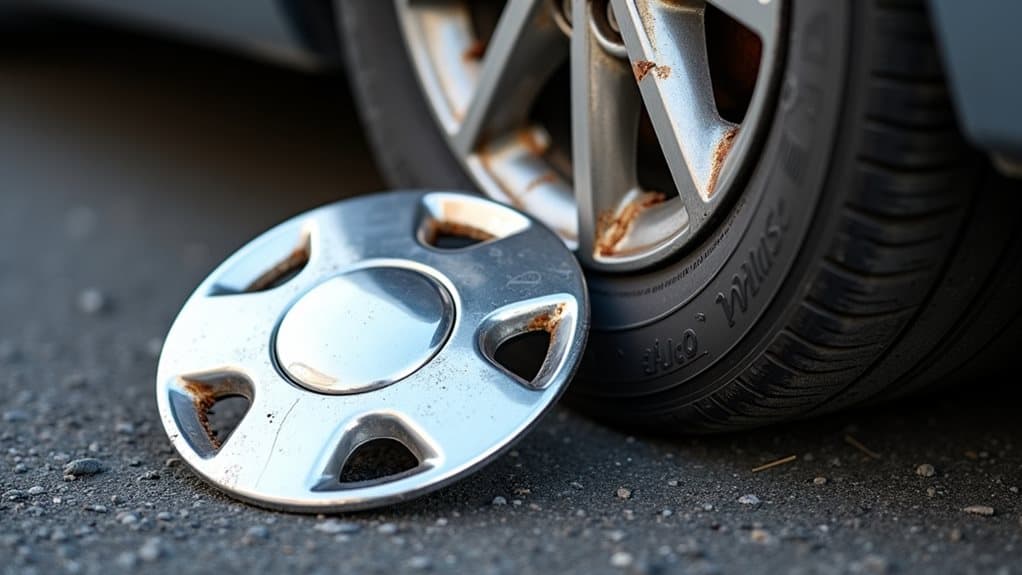
Examine your hubcap system regularly to catch deteriorating components that threaten secure attachment.
Replace cracked retention clips immediately, as they’re inexpensive but critical for preventing loss.
Damaged hubcaps with cracks or warping won’t grip wheels properly.
Check fasteners and nuts for tightness, replacing missing pieces promptly.
Corroded wheels prevent proper hubcap seating, requiring repair or replacement.
Wrapping Up
You’ll prevent hubcap loss by selecting properly sized caps with strong retention systems, installing them correctly on clean wheels, and maintaining them regularly. Check your hubcaps monthly for loose clips or damage, and replace worn components immediately. Drive carefully over curbs and potholes, as impacts weaken retention mechanisms. Consider aftermarket retention rings for extra security on precious hubcaps. Following these practices guarantees your hubcaps stay securely attached for years.

